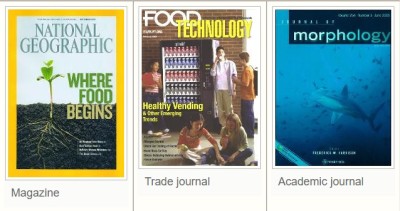Your Guide to 12 Types of Trade Journal Articles

8 Blog Posts That Set You Apart From The Pack

8 Types of E-mail Content
One of the best ways to establish yourself as an authority in your niche is to write and publish articles to an audience of your peers or in a trade journal geared toward people who keep an eye on your industry. A trade journal can be distinguished from an academic journal in two ways.
- First, by the types of articles published;
- Second, by the target readership of the periodical. Academic journals are usually geared toward academics and researchers in a particular field while trade journals appeal to professionals in a particular industry.
American Banker is the name of a trade journal for banking industry executives in the U.S. Publishers Weekly features information relevant to publishers. Internet Retailer is a trade magazine for e-commerce professionals, or business owners and managers that operate a retail store online. Thousands of other trade publications target specific industries and feature articles for professionals in those industries.
For the purposes of this blog post, references to trade journal articles include any article published in a traditional print trade journal or online and that targets professionals within a specific industry. Thanks to the Internet, these types of articles can be published a variety of digital and print media.
12 Types of Trade Journal Articles That Make Great Promotional Content
Without further ado, I present to you 12 types of articles you’ll find in most trade publications, both print and digital, and how they benefit your business when you have them published with your byline.
1. Fact-Based Articles
Fact-based articles are articles that simply rely on verifiable information. They often require research and length is not an issue. Many trade journals publish smaller articles in the range of 500-700 words. Others might well publish longer articles in the 2,000-3,000 word range. It depends on the journal. But all trade journals will be relevant to professionals working within the trade.
Even if your customers aren’t reading the trade journals associated with your profession, you might consider writing an article for a trade journal. The exposure could increase your standing among other professionals within your industry and lead to other opportunities. Your customers will have a deeper respect for you because of your status as trade journal author. If you are writing to other members of your profession, then your customers will perceive you as the consummate expert in your field.
2. News
 Every trade has industry news that all professionals want to keep up with. Those might include new scientific discoveries, changes in personnel at leading companies, new product launches, emerging trends in business, mergers and acquisitions, and other industry business that might not be reported on by mainstream news outlets. If you are in a position to uncover the news before anyone else, reporting on that for your industry’s trade journal might be what you need to expand your reputation as an authority.
Every trade has industry news that all professionals want to keep up with. Those might include new scientific discoveries, changes in personnel at leading companies, new product launches, emerging trends in business, mergers and acquisitions, and other industry business that might not be reported on by mainstream news outlets. If you are in a position to uncover the news before anyone else, reporting on that for your industry’s trade journal might be what you need to expand your reputation as an authority.
3. Trend Reports
 Trend reports are just as they sound. They are a type of news report that focuses narrowly on emerging trends withn a particular industry or profession. Cutting-edge professionals in any niche will want to stay on top of the trends, which is why trade journals tend to publish this type of article.
Trend reports are just as they sound. They are a type of news report that focuses narrowly on emerging trends withn a particular industry or profession. Cutting-edge professionals in any niche will want to stay on top of the trends, which is why trade journals tend to publish this type of article.
4. Forecasts
Related to the trend report is its close cousin, the forecast. This type of article focuses on what professionals within a particular trade might expect in the near, far, and mid-term future.
A forecast is not a prediction, and it’s a far cry from a prophecy. Rather, good forecasts are based on current data regarding trends and the important news of the day. It takes a look at the past and the present in an attempt to better understand the future direction of the industry being reported on.
5. Review articles
A review article is an article that serves as a summary on the current thought on a particular topic. For instance, if there are a wide variety of views on a particular procedure for putting out fires, a review article will provide an overview of each of the acceptable views for your niche audience. A review article can be as long or short as necessary to give an adequate description of every relevant view on the topic.
6. Case studies
 Case studies are stories that tell about the success or failure of a particular individual, company, or project related to your niche. They can be written in first person or third person.
Case studies are stories that tell about the success or failure of a particular individual, company, or project related to your niche. They can be written in first person or third person.
If you are telling someone else’s story, you’ll have to interview that person to determine what their goal was and how they went about meeting that goal. If the story is your own, be sure to let your audience know what you were trying to accomplish and whether you succeeded or not.
Case studies offer specific details about how the subject went about performing the tasks described, even if he or she didn’t succeed in the end. Most case studies are success stories, but a case study doesn’t have to tell how a person succeeded in order for it to be of value to your readers. People can learn from failure too.
7. Opinion or Commentary
Is there a hot topic of discussion in your industry? Opinion articles, or commentary, simply provide your point of view on a controversial topic or item of interest. Be sure to provide data that backs up your ideas.
8. Book or product reviews
Many trade journals publish book or product reviews. You have to be careful with criticism, however. Don’t simply write a bad review to trash a competitor or someone you don’t like. The purpose behind the review is to provide a thoughtful analysis that will benefit the reader.
9. How-to
How-to articles are some of the most helpful articles in any trade journal. Everyone wants to know how to do something. If you have a specialized knowledge on a particular subject, you can share that knowledge with your peers in your industry’s trade journal.
10. Interviews/Profiles
 Everyone loves an insightful interview or profile of a celebrity. Find someone in your industry that is well-known and ask them if you can interview them for your article. You can format the article as an interview or tell it in narrative style like a feature story. Be sure to follow the guidelines of the trade journal you plan to submit your story to. Personality profiles typically provide an overview of the important details of a person’s professional life.
Everyone loves an insightful interview or profile of a celebrity. Find someone in your industry that is well-known and ask them if you can interview them for your article. You can format the article as an interview or tell it in narrative style like a feature story. Be sure to follow the guidelines of the trade journal you plan to submit your story to. Personality profiles typically provide an overview of the important details of a person’s professional life.
11. Advertorials
An advertorial is often a full-page article that is paid for by the subject of the article. It reads like an article, but it’s a one-sided advertisement that lays out the advantages of a particular product or service. They can be very powerful stories, but the advertiser pays the trade journal for the exposure rather than the trade journal paying the writer for article content. The trade journal will likely let readers know somewhere within the content that the article is an advertorial and was paid for by the subject of the article.
12. Experimental Report
Experimental reports are more common in academic journals, but some trade journals allow professionals within their industry an opportunity to publish a report on a new method of doing something. For instance, if you invent a new kind of pest control and you’ve been using it in your pest control business, then a journal serving your industry might be interested in publishing your findings. How successful is your new method of pest control? Did you have any challenges? What were they and how did you overcome them?
It’s important to be honest in your experimental report. If your experiment failed, say so, but give your readers an explanation about why you think it failed and why that matters. If the reader can’t learn something from your report, it isn’t going to be helpful, and it likely won’t be published.
How to Get Your Trade Journal Articles Published
 Trade journal articles are most commonly published in trade journals. Some trade journals are actually magazines, so “trade publication” might be a more apt term.
Trade journal articles are most commonly published in trade journals. Some trade journals are actually magazines, so “trade publication” might be a more apt term.
While trade journals are the primary publishing vehicle for trade articles, they aren’t the only place to get your trade articles published. Other potential places to get your articles published include:
- Blogs within your industry
- Online news portals that serve your niche
- Newspapers
- Books, and
- Other publications–both digital and print–that accept solicited articles. Some publishers put out a call for such articles periodically while others take submissions. Either way, you’ll have to identify the person who will receive and review your submission and send your article to that person.
There are generally two methods for submitting articles for review. You can write the article first and submit it or you can query the editor of a blog, journal, etc. and gauge interest before writing the article.
Calls for Submission
If you are responding to a call for submissions, be sure to follow the guidelines stated in the call and follow them explicitly. If the publisher requests that your article be double-spaced in 14-point Times New Roman and you submit a single-space manuscript in 12-point Courier, your article will be rejected before it’s read. Editors receive a lot of submissions and are very busy professionals. Their guidelines may seem arbitrary to you, but they help the editor sort through manuscripts, save time, and find writers they like working with. Make sure you present your article exactly how it’s requested in the call for submissions.
When you submit your manuscript, include a short cover letter that tells a little bit of something about yourself. Don’t make it too long, but do make it interesting. Your editor wants to know that you are a real person, so be conversational but professional.
Make sure you address the cover letter, and the manuscript, to the right person, and send it to the right e-mail address (or snail mail address if the publisher wants a physical copy of the article). You’d be surprised how many people get this wrong.
Queries
Trade journals don’t often publish calls for submission. Many don’t accept queries, but some do. If you are querying an editor for an article you want to write, make sure you include all the pertinent details. I like to provide an outline of the proposed article that details my talking points. When I am done with the query letter, half the article is already written because the editor knows exactly what direction I plan to take when I writ it.
Article Submissions
More often than not, you’ll simply send your article to the trade journal or publication you want to be published in. However, your best bet is to look for submission guidelines on their website. The submission guidelines will tell you how the editor wants you to submit your article. Make sure you follow those guidelines to a tee.
When you submit an article for publication, submit it in a format that is easily readable and in a font that is easy to read. Don’t get fancy with font sizes, colors, etc. Be professional. It is okay to include your name in a byline format at the beginning of the article. You should also come up with a potential title for the article. The editor may change it, but that’s her prerogative. You’ll also want to be easy to work with. Some editors will send an article back with requests for revision. You don’t necessarily have to make every requested change, but do be professional and easy to work with. If you do reject an editor’s suggested changes, provide a good reason why your way is better. Editors respect writers that can defend their work, but do honestly consider an editor’s suggested changes because they know their audience better than you do and may suggest a change that will sit better with that audience.
The Benefits of Being Published at Specific Venues
 As previously stated, not all trade articles need to be published in a trade journal. You may want to publish your article on a blog that services your industry, in a newspaper, or somewhere else. Here are the advantages to submitting your articles at each type of venue.
As previously stated, not all trade articles need to be published in a trade journal. You may want to publish your article on a blog that services your industry, in a newspaper, or somewhere else. Here are the advantages to submitting your articles at each type of venue.
Trade Publication
Trade publications serve professionals within your industry. By getting published in a trade journal, you are positioning yourself as an expert among the experts. Don’t do it just for your ego. Do it because it will increase your stature as an authority in your niche.
Niche Blogs
Blogs are popular and easy to read. Your article might actually be seen by more readers on a blog that services your industry than it would in a trade journal serving your profession. That’s because it potentially is accessible to everyone on the planet.
Trade journals usually publish statistics on their readers for advertisers, so you can see how many people may potentially read your article by asking for readership stats. Bloggers usually know how many readers they have, as well, but blog readers are not necessarily made up only of industry professionals. If your article might be relevant to a general audience, or readers who aren’t necessarily professionals within your industry, then you can submit your article to blogs within your industry.
Another advantage to publishing on a blog is you’ll often get a bio with a link back to your website. Readers can click through to learn mor about your and your business.
In some cases, you might be able to publish an article that first appeared in a trade journal on a blog. Before you submit, ask if the blogger accepts reprints. Some will, some won’t.
Industry News Portals
Treat online news portals like print trade journals. They are essentially the same thing. In fact, some trade journals that started as print publications have migrated their content to online portals. Some publish in both formats. You could have your trade journal article published in print and online.
Newspapers
While getting published in a daily newspaper isn’t as prestigious as it used to be, many newspapers still publish op-ed pieces. Look at the newspaper’s website for the submission process. Also, make sure your op-ed piece is relevant to a general readership, and don’t write anything too technical. Newspapers present content on a sixth grade reading level, so make sure you write at that level.
Books
 Sometimes, book publishers put out a call for submissions for articles they plan to publish as chapters in a book. These are rare opportunities, but if you get a chance to have a chapter in a book, go for it. You’ll reach an entirely different audience than you would by publishing your article in a trade journal or on a blog. And the good news about book publishers is they will often accept reprinted material.
Sometimes, book publishers put out a call for submissions for articles they plan to publish as chapters in a book. These are rare opportunities, but if you get a chance to have a chapter in a book, go for it. You’ll reach an entirely different audience than you would by publishing your article in a trade journal or on a blog. And the good news about book publishers is they will often accept reprinted material.
If your article is long enough to be a book manuscript, you can submit it to a publisher that targets your niche. There is no feeling like having your name on the cover of a book.
In today’s fast-paced digital publishing marketplace, there are a ton of ways to get your niche articles published. Every one of them will position you as an expert in your niche. You will be viewed as an authority, and the more bylines you publish in your name, the higher the chances you will be seen as an authority by more people relevant to your business.
 Are you ready to boost your authority? Looking for ways to expand your reach and deliver the best content for your niche audience? Download my free report, “14 Types of Authority Content“. Learn the 14 types of content that will keep your audience coming back for more and instantly make you an authority they can rely on.
Are you ready to boost your authority? Looking for ways to expand your reach and deliver the best content for your niche audience? Download my free report, “14 Types of Authority Content“. Learn the 14 types of content that will keep your audience coming back for more and instantly make you an authority they can rely on.


